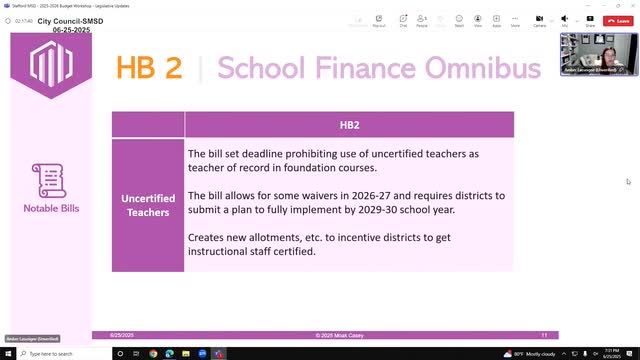Texas schools implement teacher certification pathways and funding reforms
June 30, 2025 | STAFFORD MSD, School Districts, Texas
This article was created by AI summarizing key points discussed. AI makes mistakes, so for full details and context, please refer to the video of the full meeting. Please report any errors so we can fix them. Report an error »

In a recent meeting held at Stafford City Hall, officials gathered to discuss significant changes in teacher certification and funding pathways that could reshape the educational landscape in Texas. As the conversation unfolded, it became clear that the state is poised to address the pressing need for certified instructional staff, particularly in the wake of challenges posed by the COVID-19 pandemic.
Amidst the backdrop of city hall's bustling atmosphere, one speaker emphasized the importance of remaining vigilant but not panicking over current staffing shortages. "There's lots of additional funding and pathways for incentives to get districts to hire certified instructional staff," they noted, hinting at forthcoming guidance from the Texas Education Agency (TEA) aimed at easing the hiring process.
The discussion highlighted a pivotal shift in the state's approach to teacher preparation, embedded within a broader school finance reform bill. This legislation aims to create new allotments for preparing and retaining educators through partnerships with educator preparation programs. The speaker pointed out that many Texas districts have established relationships with higher education institutions and education service centers, which are crucial for developing effective teacher certification pathways.
However, the urgency of the situation was palpable, as many districts have resorted to hiring uncertified teachers due to staffing shortages. "Reinvigorating the teacher prep workforce is a significant portion of this bill," the speaker asserted, underscoring the need for a robust strategy to ensure that future educators are well-prepared.
As the meeting progressed, the focus shifted to the various certification pathways available, including funding streams designed to support districts in nurturing their own teachers. This initiative aims to allow teachers to receive compensation while undergoing preservice training, a crucial step in building a sustainable workforce.
The implications of these discussions extend beyond immediate staffing concerns; they signal a commitment to enhancing the quality of education in Texas. As the TEA prepares to roll out new guidance in the coming months, educators and administrators alike are hopeful that these reforms will lead to a stronger, more qualified teaching workforce, ultimately benefiting students across the state.
Amidst the backdrop of city hall's bustling atmosphere, one speaker emphasized the importance of remaining vigilant but not panicking over current staffing shortages. "There's lots of additional funding and pathways for incentives to get districts to hire certified instructional staff," they noted, hinting at forthcoming guidance from the Texas Education Agency (TEA) aimed at easing the hiring process.
The discussion highlighted a pivotal shift in the state's approach to teacher preparation, embedded within a broader school finance reform bill. This legislation aims to create new allotments for preparing and retaining educators through partnerships with educator preparation programs. The speaker pointed out that many Texas districts have established relationships with higher education institutions and education service centers, which are crucial for developing effective teacher certification pathways.
However, the urgency of the situation was palpable, as many districts have resorted to hiring uncertified teachers due to staffing shortages. "Reinvigorating the teacher prep workforce is a significant portion of this bill," the speaker asserted, underscoring the need for a robust strategy to ensure that future educators are well-prepared.
As the meeting progressed, the focus shifted to the various certification pathways available, including funding streams designed to support districts in nurturing their own teachers. This initiative aims to allow teachers to receive compensation while undergoing preservice training, a crucial step in building a sustainable workforce.
The implications of these discussions extend beyond immediate staffing concerns; they signal a commitment to enhancing the quality of education in Texas. As the TEA prepares to roll out new guidance in the coming months, educators and administrators alike are hopeful that these reforms will lead to a stronger, more qualified teaching workforce, ultimately benefiting students across the state.
View full meeting
This article is based on a recent meeting—watch the full video and explore the complete transcript for deeper insights into the discussion.
View full meeting
